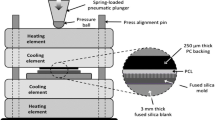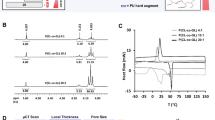Abstract
In this paper, we created a dynamic adhesive environment (DAE) for adipose tissue-derived mesenchymal stem cells (ADMSCs) cultured on smart thermo-responsive substrates, i.e., poly (N-isopropyl acrylamide) (PNIPAM), via introducing periodic changes in the culture temperature. We further explored the particular role of adsorbed fibronectin (FN), an important cell adhesive protein that was recently attributed to the recruitment of stem cells in the niche. The engineered FN/PNIPAM DAE system significantly increased the symmetric renewal of ADMSCs, particularly between passages 7 and 9 (p7–p9), before it dropped down to the level of the control (FN-coated TC polystyrene). This decline in the growth curve was consistent with the increased number of senescent cells, the augmented average cell size and the suppressed FN matrix secretion at late passages (p10–p12), all of them characteristic for stem cells ageing, which equivocally tended to slow down at our DAE system. FN supported also the osteogenic response of ADMSCs (apart from the previous observations with plain PNIPAM substrata) indicated by the significant increase of alkaline phosphatase (ALP) activity at days 7 and 14. The minimal changes in the Ca deposition, however, suggest a restricted effect of DAE on the early osteogenic response of ADMSCs only. Thus, the engineering of niche-like DAE involving FN uncovers a new tissue engineering strategy for gaining larger amounts of functionally active stem cells for clinical application.









Similar content being viewed by others
References
Krishnamoorthy N, Tseng YT, Gajendrarao P, Sarathchandra P, McCormack A, Carubelli I, et al. A novel strategy to enhance secretion of ECM components by stem cells: relevance to tissue engineering. Tissue Eng Part A. 2017;24:145–56.
Ferraro F, Lo Celso C. Adult stem cells and their niches. Adv Exp Med Biol. 2010;695:155–68.
Frese L, Dijkman PE, Hoerstrup SP. Adipose tissue derived stem cells in regenerative medicine. Transfus Med Hemotherapy. 2016;43:268–74.
Caplan AI. Mesenchymal stem cells. J Orthop Res. 1991;9:641–50.
Caplan AI. Mesenchymal stem cells: cell-based reconstructive therapy in orthopedics. Tissue Eng. 2005;11:1198–211.
Prockop DJ. Marrow stromal cells as stem cells for nonhematopoietic tissues. Science 1997;276:71–4.
Baker N, Boyette LB, Tuan RS. Characterization of bone marrow-derived mesenchymal stem cells in ageing. Bone 2015;70:37–47.
Boyette LB, Tuan RS. Adult stem cells and diseases of ageing. J Clin Med. 2014;3:88–134.
Sousa-Victor P, Garcia-Prat L, Serrano AL, Perdiguero E, Munoz-Canoves P. Muscle stem cell ageing: regulation and rejuvenation. Trends Endocrinol Metab. 2015;26:287–96.
Kennedy BK, Berger SL, Brunet A, Campisi J, Cuervo AM, Epel ES, et al. Geroscience: linking ageing to chronic disease. Cell 2014;159:709–13.
Reitinger S, Schimke M, Klepsch S, de Sneeuw S, Yani SL, Gassner R, et al. Systemic impact molds mesenchymal stromal/stem cell ageing. Transfus Apheresis Sci. 2015;52:285–9.
Scadden DT. The stem-cell niche as an entity of action. Nature 2006;441:1075–9.
Phadke A, Chang CW, Varghese S. Functional biomaterials for controlling stem cell differentiation. In: Krishnendu R, editor. Biomaterials as stem cells niche. Berlin Heidelberg: Springer-Verlag; 2010.
Lukjanenko L, Jung MJ, Hedge N, Perruisseau-Carrier C, Migliavacca E, Rozo M, et al. Loss of fibronectin from the aged stem cell niche affects the regenerative capacity of skeletal muscle in mice. Nat Med. 2016;22:897–905.
Birmingham E, Niebur GL, McHugh PE, Shaw G, Barry FP, McNamara LM. Osteogenic differentiation of mesenchymal stem cells is regulated by osteocyte and osteoblast cells in a simplified bone niche. Eur Cell Mater. 2012;23:13–27.
Kuang S, Gillespie MA, Rudnicki MA. Niche regulation of muscle satellite cell self-renewal and differentiation. Cell Stem Cell. 2008;2:22–31.
Morrison SJ, Kimble J. Asymmetric and symmetric stem-cell divisions in development and cancer. Nature 2006;441:1068–74.
Teixeira A, Hermanson O, Werner C. Designing and engineering stem cell niches. MRS Bull. 2010;35:591–6.
Donzelli E, Salvadè A, Mimo P, Viganò M, Morrone M, Papagna R, et al. Mesenchymal stem cells cultured on a collagen scaffold: In vitro osteogenic differentiation. Arch Oral Biol. 2007;52:64–73.
Salasznyk RM, Williams WA, Boskey A, Batorsky A, Plopper GE. Adhesion to vitronectin and collagen I promotes osteogenic differentiation of human mesenchymal stem cells. J Biomedicine Biotechnol 2004;1:24–34.
Schneider RK, Puellen A, Kramann R, Raupach K, Bornemann J, Knuechel R, et al. Osteogenic differentiation of adult bone marrow and perinatal umbilical mesenchymal stem cells and matrix remodelling in three-dimensional collagen scaffolds. Biomaterials 2010;31:467–80.
Somaiah C, Kumar A, Mauwrie D, Sharma A, Patil SD, Bhattacharyya J, et al. Collagen promotes higher adhesion, survival and proliferation of mesenchymal stem cells. PLoS ONE. 2015;10:e0145068.
Singh P, Schwarzbauer JE. Fibronectin and stem cell differentiation — lessons from chondrogenesis. J Cell Sci. 2012;125:3703–12.
Trappmann B, Gautrot JE, Connelly JT, Strange DGT, Li Y, Oyen ML, et al. Extracellular-matrix tethering regulates stem-cell fate. Nat Mater. 2012;11:642–9.
Gattazzo F, Urciuolo A, Bonardo P. Extracellular matrix: a dynamic microenvironment for stem cell niche. Biochimica Biophysica Acta. 2014;1840:2506–19.
Bianchi MV, Awaja F, Altankov G. Dynamic adhesive environment alters the differentiation potential of young and ageing mesenchymal stem cells. Mater Sci Eng C 2017;78:467–74.
Zhang W, Zhang X, Wang S, Xu L, Zhang M, Wang G, et al. Comparison of the use of adipose tissue-derived and bone marrow-derived stem cells for rapid bone regeneration. J Dent Res. 2013;92:1136–41.
McLaughlin MM, Marra KG. The use of adipose-derived stem cells as sheets for wound healing. Organogenesis 2013;9:79–81.
Cohen S. Emerging applications of stimuli-responsive polymer materials. Nat Mater. 2010;9:101–13.
Kikuchi A, Okano T. Temperature responsive, polymer-modified surfaces for green chromatography. Macromol Symposia. 2004;207:217–27.
Yamato M, Konno C, Kushida A, Hirose M, Utsumi M, Kikuchi A, et al. Release of adsorbed fibronectin from temperature-responsive culture surfaces requires cellular activity. Biomaterials 2000;21:981–6.
da Silva RMP, Mano JF, Reis RL. Smart thermoresponsive coatings and surfaces for tissue engineering: switching cell-material boundaries. Trends Biotechnol. 2007;25:577–83.
Ward MA, Georgiou TK. Thermoresponsive polymers for biomedical applications. Polymers 2011;3:1215–42.
Okano T, Yamada N, Okuhara M, Sakai H, Sakurai Y. Mechanism of cell detachment from temperature-modulated, hydrophilic-hydrophobic polymer surfaces. Biomaterials 1995;16:297–303.
Groth T, Altankov G, Kostadinova A, Krasteva N, Albrecht W, Paul D. Altered vitronectin receptor (alpha-v integrin) function in fibroblasts adhering on hydrophobic glass. J Biomed Mater Res. 1998;44:341–51.
Toromanov G, Gugutkov D, Gustavsson J, Planell J, Salmeron-Sanchez M, Altankov G. Dynamic behavior of vitronectin at the cell-material interface. ACS Biomater Sci Eng. 2015;1:927–34.
Greenwood SK, Hill RB, Sun JT, Armstrong MJ, Johnson TE, Gara JP, et al. Population doubling: a simple and more accurate estimation of cell growth suppression in the in vitro assay for chromosomal aberrations that reduces irrelevant positive results. Environ Mol. Mutagenesis 2004;43:36–44.
Yamada N, Okano T, Sakai H, Karikusa F, Sawasaki Y, Sakurai Y. Thermo‐responsive polymeric surfaces; control of attachment and detachment of cultured cells. Macromol Rapid Commun. 1990;11:571–6.
Shimizu K, Fujita H, Nagamori E. Oxygen plasma‐treated thermoresponsive polymer surfaces for cell sheet engineering. Biotechnol Bioeng. 2010;106:303–10.
Muniandy MKR, Ruzanna AK, Intan Zarina ZA, Rohaya MAW, Sahidan S, Majlis BY, et al. Proliferation rate and cell size analyses of human peripheral blood suspension stem cells from three culturing terms populations. Malays Appl Biol. 2013;42:59–63.
Raven PH How cells divide. In: Biology 10th, Raven PH, Johnson G, Mason K, editors. New York: McGraw-Hill; 2011.
Holstein TW. Cell cycle of stem cells in hydra. Developmental Biol. 1990;142:392–400.
Geissler S, Textor M, Kuehnisch J, Koennig D, Klein O, Ode A, et al. Functional comparison of chronological and in vitro ageing: differential role of the cytoskeleton and mitochondria in mesenchymal stromal cells. PLoS ONE. 2012;7:e52700.
Legzdina D, Romanauska A, Nikulshin S, Kozlovska T, Berzins U. Characterization of senescence of culture-expanded human adipose-derived mesenchymal stem cells. Int J Stem Cells. 2016;9:124–36.
Lee BY, Han JA, Im JS, Morrone A, Johung K, Goodwin EC, et al. Senescence‐associated β‐galactosidase is lysosomal β‐galactosidase. Ageing Cell. 2006;5:187–95.
Gordon J, Hassan MQ, Koss M, Montecino M, Selleri L, van Vijnen AL, et al. Epigenetic regulation of early osteogenesis and mineralized tissue formation by a HOXA10-PBX1-associated complex. Cells Tissues Organs. 2011;194:146–50.
Shi D, Ma D, Dong F, Zong C, Liu L, Shen D, et al. Proliferation and multi-differentiation potentials of human mesenchymal stem cells on thermoresponsive PDMS surfaces grafted with PNIPAM. Biosci Rep. 2009;30:149–58.
Dedhar S. Signal transduction via the b1 integrins is a required intermediate in interleukin-1 b induction of alkaline phosphatase activity in human osteosarcoma cells. Exp Cell Res. 1989;183:207–14.
Zhao M, Harris SE, Horn D, Geng Z, Nishimura R, Mundy GR, et al. Bone morphogenetic protein receptor signaling is necessary for normal murine postnatal bone formation. J Cell Biol. 2002;157:1049–60.
An J, Leeuwenburgh S, Wolke J, Jansen J Mineralization processes in hard tissues: Bone. In: Aparicio C, Ginebra MP, editors. Biomineralization and biomaterials fundamentals and application. Woodhead Publishing - Elsevier, Cambridge, United Kingdom. 2016. (pp. 129–46).
Fakhry M, Hamade E, Badran B, Buchet R, Magne D. Molecular mechanisms of mesenchymal stem cell differentiation towards osteoblasts. World J Stem Cells. 2013;5:136–48.
Viti F, Landini M, Mezzelani A, Petecchia L, Milanesi L, Scaglione S. Osteogenic differentiation of MSC through calcium signaling activation: transcriptomics and functional analysis. PLoS ONE. 2016;11:e0148173.
Murshed M, Harmey D, Millan JL, McKee MD, Karsenty G. Unique coexpression in osteoblasts of broadly expressed genes accounts for the spatial restriction of ECM mineralization to bone. Genes Dev. 2005;19:1093–104.
Keselowsky BG, Wang L, Schwartz Z, Garcia AJ, Boyan BD. Integrin α5 controls osteoblastic proliferation and differentiation responses to titanium substrates presenting different roughness characteristics in a roughness independent manner. J Biomed Mater Res Part A. 2007;80:700–10.
Hristova-Panusheva K, Keremidarska-Markova M, Altankov G, Krasteva N. Age-related changes in adhesive phenotype of bone marrow-derived mesenchymal stem cells on extracellular matrix proteins. J N. Results Sci. 2017;6:11–9.
Nedjari S, Awaja F, Altankov G. Three dimensional honeycomb patterned fibrinogen based nanofibers induce substantial osteogenic response of mesenchymal stem cells. Sci Rep. 2017;7:15947.
Cosgrove BD, Sacco A, Gilbert PM, Blau HM. A home away from home, challenges and opportunities in engineering in vitro muscle satellite cell niches. Differentiation 2010;78:185–94.
Acknowledgements
This work was mainly supported by the European Commission through FP7 Industry-Academia Partnerships and Pathways (IAPP) project FIBROGELNET. The valuable contribution of project MAT 2015–69315–C3 MYOHEAL with the Spanish Ministry of Science and Innovation and CIBER-BBN are also acknowledged. FA acknowledges the partial support of FWF under Lise Meitner program (M-1777) and grant No 713690 provided by European Commission within the Horizon 2020 Marie Skłodowska-Curie program.
Author information
Authors and Affiliations
Corresponding author
Ethics declarations
Conflict of interests
The authors declare that they have no conflict of interest.
Additional information
Publisher’s note Springer Nature remains neutral with regard to jurisdictional claims in published maps and institutional affiliations.
Rights and permissions
About this article
Cite this article
Ramalho, L., Nedjari, S., Guarino, R. et al. Fibronectin/thermo-responsive polymer scaffold as a dynamic ex vivo niche for mesenchymal stem cells. J Mater Sci: Mater Med 31, 129 (2020). https://doi.org/10.1007/s10856-020-06461-y
Received:
Accepted:
Published:
DOI: https://doi.org/10.1007/s10856-020-06461-y




